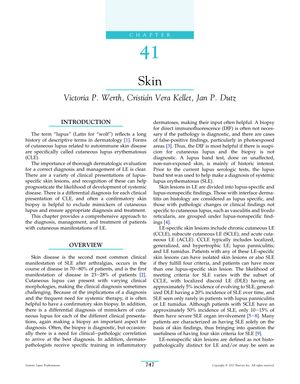Skin
January 2011
in “
Elsevier eBooks
”
Lupus Erythematosus Systemic Lupus Erythematosus SLE skin biopsy Cutaneous lupus erythematosus CLE chronic cutaneous LE CCLE subacute cutaneous LE SCLE acute cutaneous LE ACLE Discoid lupus erythematosus DLE nonscarring alopecia lymphocytic infiltrate thickened basement membrane follicular plugging Direct Immunofluorescence DIF photosensitivity cutaneous vasculitis CV antiphospholipid syndrome APS Raynaud's phenomenon RP oral ulcers nail changes papulonodular mucinosis bullous lesions Cutaneous Lupus Erythematosus Disease Area and Severity Index CLASI sun avoidance sunscreens smoking cessation topical therapies systemic therapies antimalarials immunosuppressives systemic glucocorticoids TNF-α inhibitors Lupus nonscarring hair loss sunblock antimalarial drugs immunosuppressive drugs steroids TNF inhibitors

TLDR Skin problems are common in Lupus patients and can indicate the disease's severity, requiring specific treatments and lifestyle changes.
The 2011 document highlights the significance of dermatologic evaluation in diagnosing and treating Lupus Erythematosus (LE), with a focus on its skin manifestations. It states that skin disease occurs in 70-80% of Systemic Lupus Erythematosus (SLE) patients, often necessitating a skin biopsy. Cutaneous lupus erythematosus (CLE) is divided into lupus-specific and nonspecific lesions, with chronic cutaneous LE (CCLE), subacute cutaneous LE (SCLE), and acute cutaneous LE (ACLE) being the specific types. Discoid lupus erythematosus (DLE) is the most common form of CCLE, more prevalent in females and African-Americans, and may lead to SLE in varying incidences. Nonspecific lesions can include conditions like vasculitis and nonscarring alopecia. Histological features of cutaneous lupus typically include lymphocytic infiltrate, thickened basement membrane, and follicular plugging, with a positive Direct Immunofluorescence (DIF) test in about 90% of DLE patients. The document also discusses other skin manifestations in SLE patients, such as acute cutaneous lupus erythematosus (ACLE), photosensitivity, cutaneous vasculitis (CV), antiphospholipid syndrome (APS), Raynaud's phenomenon (RP), nonscarring alopecia, oral ulcers, nail changes, papulonodular mucinosis, and bullous lesions. It emphasizes the morbidity and potential mortality associated with these skin manifestations due to systemic involvement. Additionally, the document covers the epidemiology, pathogenesis, and outcome measurement of CLE, noting the development of the Cutaneous Lupus Erythematosus Disease Area and Severity Index (CLASI) and the impact of CLE on patients' quality of life. Treatment recommendations include sun avoidance, sunscreens, smoking cessation, topical therapies, and systemic therapies such as antimalarials and immunosuppressives, with a cautionary note on the use of systemic glucocorticoids and TNF-α inhibitors for lupus-specific skin lesions.






